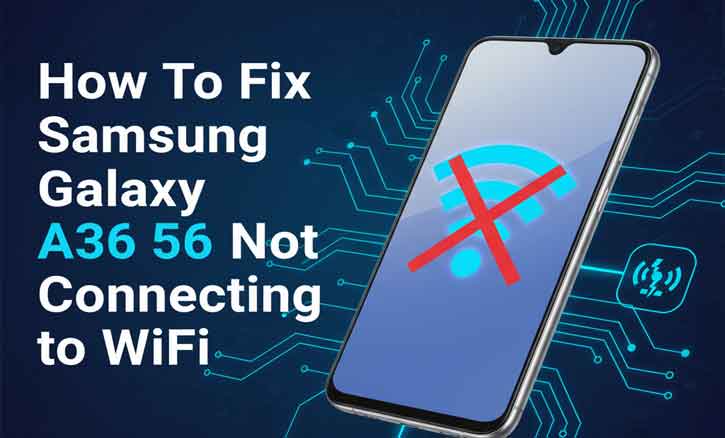
When your Samsung Galaxy A36 5G refuses to connect to Wi-Fi, it can be frustrating—especially if you rely on stable wireless connections for work, streaming, or downloads. The good news is that most Wi-Fi problems stem from simple misconfigurations, temporary glitches, or router issues, not hardware failure. This guide walks you through every step — from quick fixes to advanced troubleshooting — to help you restore a fast, stable connection.
Quick Checks — Try These First
Before diving into advanced fixes, perform these simple actions:
- Toggle Wi-Fi Off and On — Swipe down from the top of the screen, tap the Wi-Fi icon off, wait five seconds, and turn it back on.
- Restart Your Phone — Reboots clear temporary system bugs that can interrupt Wi-Fi communication.
- Toggle Airplane Mode — Turn it on for 10 seconds, then disable it to reset the network modules.
- Test Other Devices — Check if your other devices can connect to the same Wi-Fi. If they can’t, the issue likely lies with the router or internet provider.
These steps often fix short-term connection glitches caused by network cache or background system conflicts.
Common Causes and How They Show Up
If your Galaxy A36 5G still doesn’t connect, it’s time to identify the cause. Here are the most common scenarios:
- Router firmware or ISP outage: The network signal may be fine, but routing is interrupted upstream.
- Wi-Fi interference: Overlapping 2.4 GHz channels or microwave signals can cause packet loss.
- Incorrect credentials: Password or security type mismatch can cause “Authentication error.”
- Outdated firmware or OS bugs: Software updates often fix known Wi-Fi connectivity issues.
- Router restrictions: MAC address filters or parental control settings may block your phone.
- Hardware malfunction: Physical damage to the antenna or PCB is rare but possible.
Scientific research supports this: studies on wireless interference and network competition show that shared-spectrum congestion and environmental noise can significantly degrade Wi-Fi performance in mobile devices. Researchers from the University of Chicago and ACM Systems found that crowded frequency bands directly affect connection reliability and throughput.
Advanced Diagnostics
1. Analyze Wi-Fi Channels and Signal Strength
Install a Wi-Fi analyzer app to check which channels are overcrowded. Move your router or change channels to minimize overlap. A strong RSSI (signal level around -50 dBm) indicates optimal connection; anything below -75 dBm may cause frequent drops.
2. Review Wi-Fi Logs and Verbose Mode
For advanced users or technicians:
- Enable Developer Options > turn on Wi-Fi verbose logging.
- Use ADB logcat commands on a computer to analyze Wi-Fi driver messages and DHCP responses.
Repeated “authentication” or “IP timeout” errors may indicate firmware-level conflicts or hardware malfunction.
3. Restore or Roll Back Router Firmware
In some cases, newly updated router firmware introduces compatibility issues. Reverting to a stable firmware version or performing a factory reset on the router can solve persistent connection failures.
Preventive Tips for Stable Wi-Fi
- Keep your phone and router firmware updated.
- Use WPA2/WPA3 encryption for better security and stability.
- Place the router in an open area, away from walls or electronic interference.
- Reserve DHCP addresses for frequently used devices.
- Reboot the router at least once a month to refresh connections.
When to Contact Support or a Technician
You should contact Samsung Support or your Internet Service Provider (ISP) if:
- Your Galaxy A36 5G won’t connect while other devices work fine.
- The issue persists after all resets and updates.
- Wi-Fi hardware tests show no signal detection even in Safe Mode.
- Physical damage or moisture exposure is visible near the antenna area.
A professional technician can diagnose antenna issues, replace components, or reflash the firmware if required. Read our guide on restoring the Edge Panel feature on Galaxy A36 5G.
Scientific Insight — Why Wi-Fi Fails
Research by the University of Chicago and studies published in ACM Systems have shown that Wi-Fi reliability heavily depends on environmental factors and channel congestion. In controlled experiments, shared-spectrum competition led to up to 40% higher packet loss in dense areas. The data suggests that both device configuration and network topology directly influence wireless stability.
As these findings conclude, “Addressing both device-level configuration and environmental interference is essential for maintaining stable Wi-Fi connectivity in modern mobile systems.”
Conclusion
Your Samsung Galaxy A36 5G is a capable smartphone with strong wireless hardware. Most Wi-Fi connection issues come from temporary conflicts or router misconfigurations, not permanent faults. By following this structured troubleshooting guide, you can isolate the cause, apply the right fix, and restore a reliable internet connection without unnecessary repairs.
If after all steps your phone still fails to connect, it’s best to let a certified Samsung technician perform a hardware-level diagnosis.
FAQ
1. Why does my Galaxy A36 say “Connected but no internet”?
This usually means your phone connected successfully to the router but the router itself has lost its internet link. Restart the router and test with another device.
2. Why does Wi-Fi disconnect randomly?
Background power-saving modes, interference, or an unstable DHCP lease can trigger dropouts. Disable adaptive battery temporarily to test.
3. Is 5 GHz better than 2.4 GHz?
Yes. The 5 GHz band offers faster speeds and less interference, though it has a shorter range.